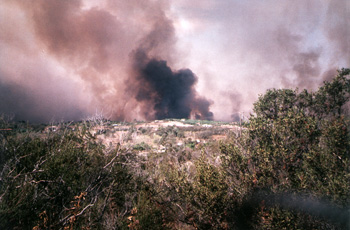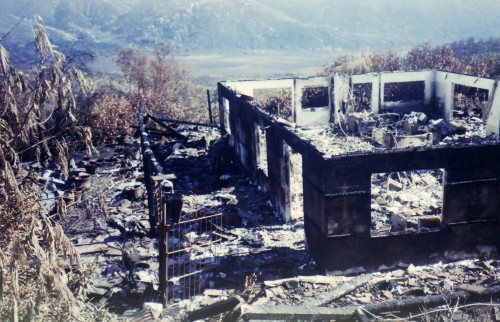The winds kicked up over last weekend, here in Texas – and it was wonderful, after what seems like an eternity of soggy, brutal and unrelenting heat. It has rained here in San Antonio precisely twice in the last three or four months, and the second rain was nothing but a thin mist that moistened the ground and dried up almost at once. The temperatures have been in the 100s, all summer long, and now most of Texas is dried to a crisp. Seasonal watercourses are bone-dry. Even in the spring, when my daughter and I took the dog and walked along the Salado Creek Greenway, there were only occasional stagnant pools of water in the creek bed.
The winds cooled everything down by about ten degrees – but they also revived memories of what it was like, when I was growing up in the hill country the hill country of Southern California. Then it would be hot and dry all summer long, the green grass of spring would turn gold, the chaparral the native brush would dry out . . . and then . . .
The winds would blow, the hot dry devil winds from off the high desert, which some called the Santa Ana, and others insisted was Santanna. And then the hills would burn. A spark from a string of broken Christmas lights, the sun shining relentlessly through a piece of bottle grass, a bulldozer blade striking a buried flint rock . . . or even some fool throwing a lit cigarette out of a car window, or messing around with fireworks. Within seconds the sparks turn into flames, and the hills would burn, with the hot desert wind fanning it to a greedy blow-torch roar.
A well-lit brush fire does make that horrible, deep roaring noise as it burns, a noise to make everyone hearing it feel cold and afraid down to the toes of their boots. Once fire is well along, and a stiff wind pushing, there is very little to be done only see that it is deflected from structures. At a distance, the clouds of smoke pile up in the sky like thunderheads. There’s no mistaking the smell of a distant fire, the pale beige smoke of it hanging in the sky . . . or mistake the fall of fine ash, drifting in eddies along the ground for miles distant and days afterwards.
(My father took this picture, of the advancing fire that burned his and Mom’s retirement home in the fall of 2003. The black smoke indicates that something more than brush is burning – probabaly a garage or shed.)
It is an unforgettable sight, seeing a runaway fire, especially at night. In the fall of 1975, from the hilltop above my parents’ home, I watched such a fire, advancing over the mountaintop crests of the Angeles National Forest, a line of fire across the horizon as far as one could see. We escaped that particular conflagration, thanks to being across a well-built up valley from the closest point that fire came to us, but nearly three decades later, my parents were not so lucky. They had retired to Valley Center in northern San Diego County and in the Paradise Mountain fire, theirs was one of the houses lost. They had twenty minutes to pack their vehicles and go, losing nothing but things things which can be replaced, although some of them pictures, books, certain items of china and relics were sorely missed.
Even now, while some fires are contained, more are burning. (Round-up here.) There is a pale, dusty haze in certain directions, and a faint odor of smoke. And of course, we are nervous – given past experience. Last Saturday afternoon, when my daughter went outside to water the plants, she came back, exclaiming excitedly that she smelled smoke. There was something burning, something to the north and east of us, borne on the wind. We know that smell, that hazy look in the sky. My daughter called the local non-emergency number, stressing over and over again, that there was something on fire close to us. Given the drought and the strong winds and our own experiences; enough to make both of us jumpy. Eventually, the operator told her that yes, there was a fire in a house over on Judson, which we agreed was probably what we had smelled. My daughter was so shaken that she went out and watered down all our yard within reach, aiming the spray up into the trees and over the fence into the green belt now the brown belt. On Labor Day afternoon, we spotted the smoke of another fire away up north, towards Bulverde. She went and watered everything again, just to be sure.
Hearing the sound of sirens at this time of year, my mother used to tell us to run up to the top of the hill, and see what on fire, and on our report a house down in town someplace: “Oh, only a house, then. Not the hills.” But that’s what you always think, in fire country.
(Another picture taken by Dad – after the fire had passed. The house was rebuilt, with improvements. He and Mom always considered themselves lucky among those who were burned out by that fire. They did not lose any family members, pets or a business. Only things – which can be replaced.)


And believe it or not, the general trend line in Texas has been and still is for less drought conditions and the current drought is not all that severe.
click the graph . . .
http://tinyurl.com/3byn86n
Thanks for sharing. Tom Smith of The Right Coast, who lives near San Diego, occasionally blogs about his fire preparations. His latest post is here.
Same problem, different country, different solution.
Somebody in Texas should get the US Marketing Rights t this technology.
http://www.bushfirepro.com/index.php?cat=13
With the humidity there you must be miserable.
California is used to fires – particularly southern California when those hot Santa Ana winds start about now.
I think a lot of these fires are exacerbated by these environmentalists who don’t want forests cleaned out of dead wood. I know in Lake Tahoe – it was very bad because of all the rules put by the Tahoe regional planning committee – who never seems to be called to task.
A friend in Santa Barbara – with that fire a couple of years ago – had between notification and time to evacuate – about 10 minutes.
Not much to pack up in that time…
No, Fred – it’s only a bit drier and hotter than it’s been in about fifteen years. We’ve had some relatively pleasant summers, now and again – there was one a couple of years ago where it rained every two weeks, so heavily that the wildflowers stayed until August, and a visitor insisted that South Texas was as green as Ireland, practically.
My parents were always … well, almost paranoid about fire danger, and preparations – and it’s interesting to see that formal preparations have gone beyond a swimming pool and a stirrup-pump. The recieved wisdom was that if you could only keep the roof wet enough, the fire would burn past you. Mom and Dad had to put up a storage tank on the hill above their house, of such-and-such a capacity. Dad made it look like a round and rustic tower.
Bill – as my Dad used to insist during our nature-walks – the ecology of California (and a fair number of other places, like the upper Plains and Great Basin) are built upon wildfires burning through on a regular basis. It just is neccessary, to clear out the load of burnable stuff, to germinate the seeds of new plants. IIRC, in California chaparral, the optimum is about every thirty years or so. If you put it off too long, there is too much stuff which will burn at super-heated temperatures, which will destroy mature trees – which might have been unscathed by a fast-moving flash-fire – and bake the ground into a hard, impermeable crust.
No, ten minutes not a long time at all. Just enough to grab the kids, the pets, the purse, the photo albums, and the strongbox of papers, plus any jewelbox with essential jewelry. Always grab the photo albums. You can get back most things, or something close to it, but you can never get back family photos. One of the most regretted losses for us was a huge box of family photos, which my daughter had been sorting through. She near as dammit took it with her, when she transferred from Camp Pendleton to Cherry Point. She looked at it on the morning she left my parent’s house to drive east, thought about taking it with her … and didn’t. Two weeks later, that box burned up real good.